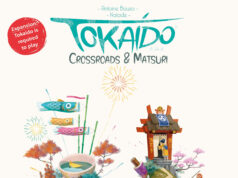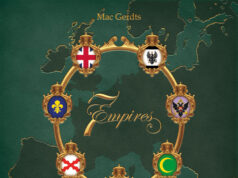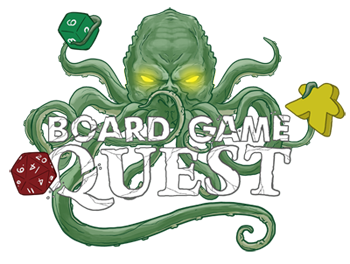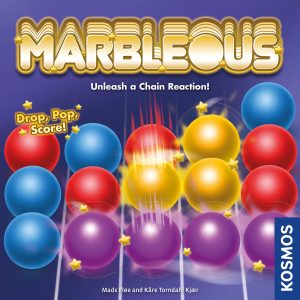 Besides using misleading advertisements about them, there are several common types of mobile games these days. Merge various items, RPG-like battlers, and match three of a shape/color are some of these ubiquitous games.
Besides using misleading advertisements about them, there are several common types of mobile games these days. Merge various items, RPG-like battlers, and match three of a shape/color are some of these ubiquitous games.
Today’s review is a tabletop version of the latter of these: Marbelous by Mades Fløe and Kåre Torndahl Kjær and published by KOSMOS. It plays one to four players ages eight and up and plays in 30 to 45 minutes.
Gameplay Overview:
Each player’s turn starts with selecting one of the three face-up marble cards. This will grant two to three marbles to be added to that player’s tray in any of the four orientations of the card. That player could also opt to play a single marble token to add one marble of the specified color.
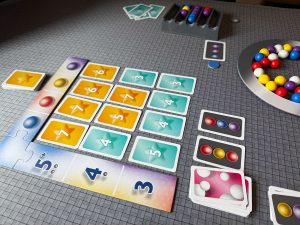
Then, if there’s any sets of three or more marbles of the same color touching orthogonally, they get removed from the tray and scored. After the marbles settle any additional sets of three or more also get scored.
Scoring is straightforward with the active player looking at the matrix of scoring cards and grabbing the one that intersects the color and number of marbles that match. Then all remaining cards in that column drop down. For matches of four and five or more marbles, you’ll also gain one or two marble tokens, respectively, to use on a future turn.
Once all the blue scoring cards have been used, the gold cards start appearing. The game continues until there are no more marble cards available to be added. Highest score wins.
There’s also an advanced mode and a solo mode that I’ll get into during the game experience section.
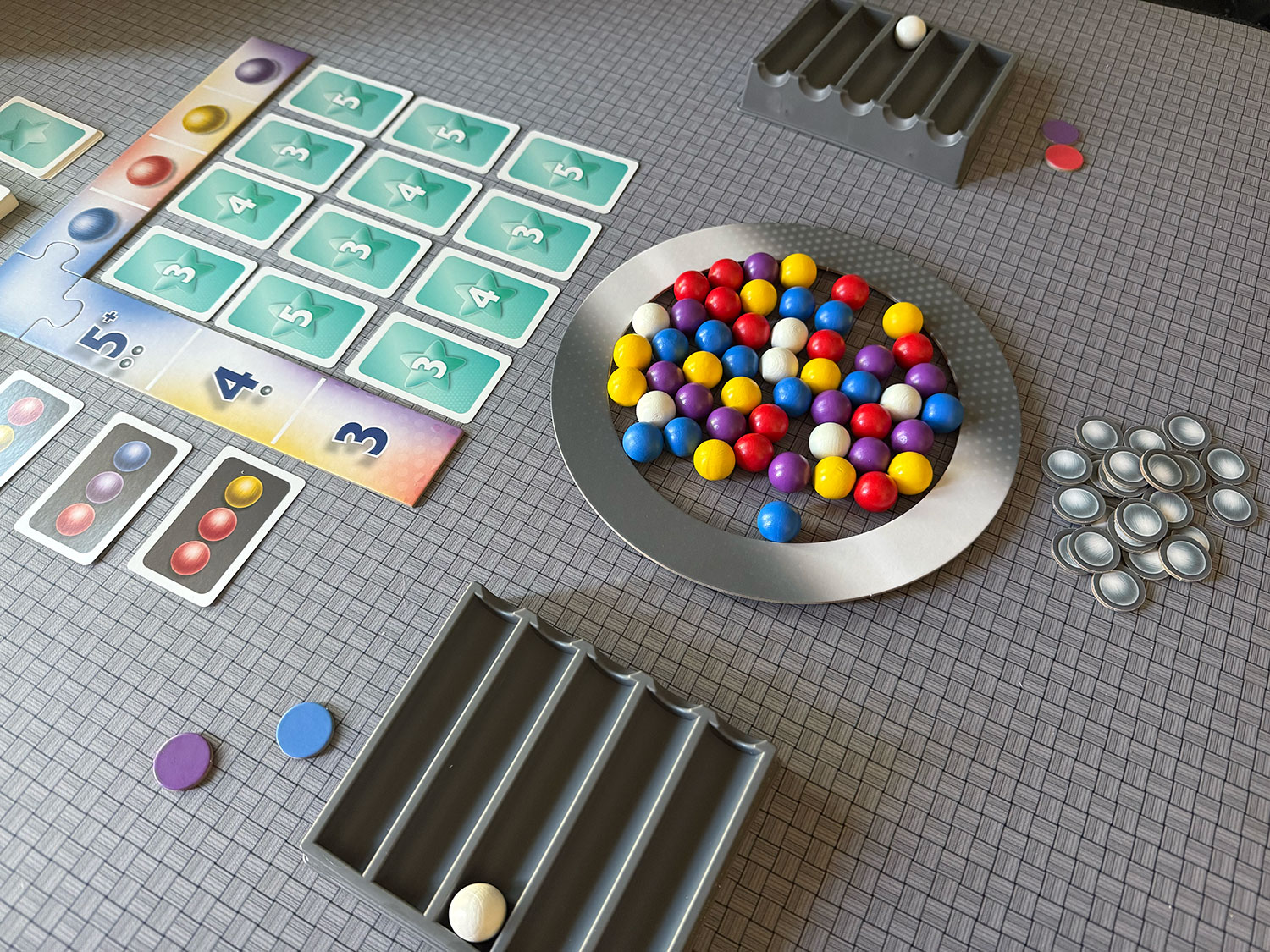
Game Experience:
I’ve spent way too much time playing Puzzle Quest (Marvel and the vanilla version) as well as Bejeweled and several other games in this genre on various devices, so I was drawn to this game as a tabletop version. And Marbelous is for all intents and purposes, a match three game without the intrusive advertisements.
The matches don’t have to be in a line, making clusters or L’s of a color possible scoring opportunities. There’s not a lot of incentive to look for massive groupings, as scoring tops out at 5 marbles.
Being able to pick the order you pop/score the combo can allow for multiple scoring opportunities in a turn, and grabbing two or more cards, instead of one, can be impactful. Meanwhile, stockpiling bonus tokens, while always helpful, is a bit more limiting with the one token per turn restriction. This is a game that allows you to score on most turns or build up for a bigger combo on a future turn.
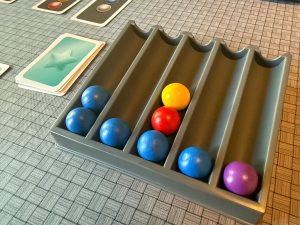
The advanced mode grants star tokens each time you pop two or more sets in a single turn. And these, in turn, are worth an increasing number of points based on how many you earn (one star is worth three points, but four stars is worth 15 points, for example).
Solo mode can be played with the advanced rules or not, and is “beat a score” with three levels of difficulty. Each turn, the marble cards that aren’t selected are removed and, like the base game, drive the overall game length. Along with discarding a marble card, a random scoring card is also removed, pushing the better gold cards out faster. The second part of the solo mode is that you need to get four marbles of a color in a specific order, and you need to complete all four before the game ends.
Scoring enough solo to beat the easy level was a 50/50 prospect for me, so there’s a lot of opportunity to improve before I can claim to be good at this, especially with the advanced mode. And I think solo might be my favorite way to play, as you really need to plan for combos to earn the star tokens to earn enough points to win. And it’s a game where I feel like I have improved with repeated plays as I’ve learn how to best deal with cards dealt and play with some patience to get combos.
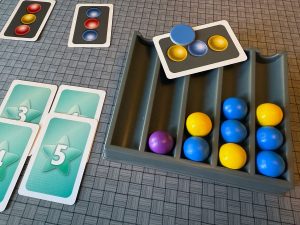
In a two-player game, you know that two of the three cards at the end of your turn will be there when it’s your play again. However, with just four colors, plus wilds, you’ll likely be able to make to get a match most turns, especially if you have tokens to use. And while someone could hate draft, losing the card you’re hoping for is a light setback at worst. The potential loss of short term strategic game play is about the only meaningful difference between higher and lower player counts besides game length, which does get longer. I could argue it’s harder to plan ahead but it’s kind of a stretch.
For me, this fits into the gateway game category and is a solid family game without an IP attached to it. It’s an abstract game without direct player conflict, so it could check a lot of boxes for people. I like the plastic trays and wooden marbles (though plastic or glass ones could also look amazing) and think the toy factor will be a draw for some people. The cardboard ring that corrals the marbles is easy to knock around, so expect to chase marbles around the room, especially if you play with younger children (or their clumsy adults).
The good thing about all of this is that it works well and is pretty easy to teach and play. The downside is that it’s pretty basic, and even the advanced mode doesn’t add a ton to overall game depth. That’s not a bad thing, but, much like Bejeweled, sometimes you just want something that’s simple fun for a period of time. Not everything needs to be a three-hour long brain burner.
Going back to phone apps, I preferred Puzzle Quest over Bejeweled because of the added depth of character abilities, and depending on the version, equipment, crafting, and/or spells. And, much like the apps, I think the simplicity of Marbleous, while a boon in some regards, does limit my long-term prognosis for this game, especially if I feel like I’ve mastered the solo mode.
Final Thoughts:
Marbleous. Absolutely marbleous, darling.
Well, sort of. Marbleous is a simple, colorful, and fun match three game on your tabletop. And while it’s fun, I have a hard time seeing it becoming a staple with my family, as evidenced by everyone wanting to play other games when asked if they want to play Marbleous.
For my tastes, it’s a little too light to be a long-term keeper as I feel like I’ve experienced what it offers in nearly a dozen plays, but I can also see keeping it as a gateway game for less board game savvy friends and family or until I’m able to beat the solo mode. But even as I finish this review, I kind of want to see if I can score better than my last game.
Final Score: 3 Stars – Marbleous replicates a streamlined match-three style gameplay from your phone to the tabletop.
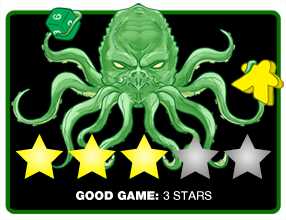 Hits:
Hits:
• Familiar mobile game match-three concept
• Easy to teach and plays quickly
• Satisfying to score most turns or build up for a combo
• Solo mode is challenging
Misses:
• Not a whole lot new experiences after a few plays
• Marbles will probably need to be wrangled at some point
• Maybe if it’s a little harder to strategize at higher player counts








